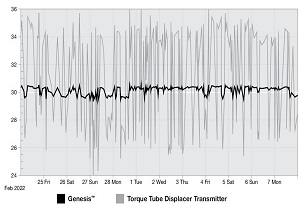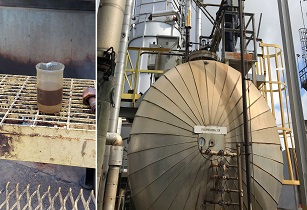A Genesis Multiphase Detector with a 106-inch long Pentarod probe was installed on a 13-foot diameter desalter at a refinery in the Eastern United States for monitoring and comparison versus an existing Fisher torque tube displacer transmitter
Desalters are an important process element at refineries as desalting removes both salt and residual free water. The goal in this application is to keep the interface level constant for optimum efficiency. The challenge is that interface level must be accurate enough to control and keep free water from contacting the desalter electrodes, which can cause expensive damage.
Test results
Commissioning was confirmed via comparison to visual samples taken from side taps with initial indications showing a torque tube error of up to 20%. Three weeks later, an upset within the vessel was significant enough to disable the torque transmitter to the point where it would no longer read below 70% level. At one stage during the displacer malfunction, it was proven (by customer via side taps, and later by viewing the %Water Graph on the Model ED1 DTM) that there was actually water ABOVE the oil in the vessel, as described by the customer:
“At first I thought we were getting incorrect readings but after testing at the taps, the readings were correct. We actually had higher water content at higher points in the vessel compared to lower points in the vessel. Due to the displacer level not working, we have added a selector switch to use the new probe to control the level. We are now controlling our water level with the new probe! This will give us potentially another month of runtime with this vessel before we have to take it out of service for cleaning. Not having to clean the vessel and displacer at this time will save us thousands of dollars and save manpower for other work. I did not want to use the probe for control until we went through more testing but I couldn’t pass up on the opportunity.”
With the Model ED1 in control for three weeks:
“Everything is going well. We are still controlling the desalter with the probe. The feedback we have received from our chemical company that provides our demulsifier is very positive. She said it is the best the desalter has looked in a long time. I think that it is due to the tighter control we have been able to provide with the new probe.”
Conclusion
These were immediate results, but over time, an even greater return may be seen in terms of reduced corrosion and fouling in downstream piping/equipment due to tighter control of the emulsion. In addition, level control was improved from 15-20% around the setpoint with the displacer down to 1-2% with the Genesis. They have benefited by this improved control in both time (with respect to maintenance) and money (with respect to chemical additives). Next step is to install a longer probe in place of the torque tube. A longer probe resting closer to the bottom of the vessel will allow earlier sand detection. Knowing the level of the sand will allow them to properly plan shutdowns, instead of blindly shutting down the vessel every six months for cleaning. It must be noted that not all desalters will have sand accumulation; however, many separators will indeed have sediment/sand and this device will provide enhanced visibility to all levels.
The goal from the onset was to have our device control the levels in the vessel; however, it happened a little quicker than expected.
A true success story with this new and exciting product!
For more information on Multiphase level measurements download our 'Emulsion in the field' white paper.





